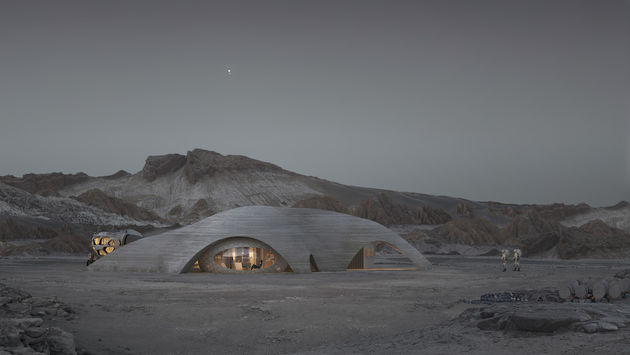 Mars habitat by Hassell. Photo by HASSELL + Eckersley O’Callaghan
Mars habitat by Hassell. Photo by HASSELL + Eckersley O’Callaghan
The Design Museum explores whether humans could get to Mars – and how we’d survive once we were there
The Red Planet has long held an allure, and in recent years the possibility of inhabiting it has inched ever so slightly closer. The Design Museum’s exhibition will immerse the visitor in various facets of existence on Mars. Assistant curator Eleanor Watson unveils its mysteries.
ICON: Why has the Red Planet held such a particular grip on our imagination?
ELEANOR WATSON: The main reason is that we have always been able to see the planet with the naked eye. Mars has been this constant presence for humans, glowing red in the sky and intriguing us with its strange movements as its orbit converges and diverges from Earth’s. Its red colour in particular has always fascinated us – with its associations of blood, war and passion – and has led it to feature in the astronomy and associated myths of almost every civilisation.
Our interest in the planet as an actual place however only really took off at the turn of the last century, when Giovanni Schiaparelli published his first maps of Mars. He famously described the dark lines he saw on the planet’s surface as ‘canali’, which was rather disastrously mistranslated as ‘canals’ rather than ‘channels’ and led to much of the Western world believing that there were, or had been, intelligent beings on Mars. The idea was that the planet was slowly drying out, and that the Martian population had built a system of canals to draw water from the poles to irrigate the rest of the planet – whether or not they had been successful was up for debate.
 Another example of a Mars habitat by Hassell
Another example of a Mars habitat by Hassell
This idea was wildly popular and dominated the public perception of Mars right up until 1965, when the first fly-by mission sent photographs back and revealed the planet for what it is – a dry, desolate landscape seemingly devoid of life. In the fifty years since the Mariner 4 mission we have learned more and more about the planet and realised just how inhospitable it is. We have also been able to see how similar it is to some parts of Earth however, and with that comes a growing desire to travel there, and a temptation to think of it as a ‘Planet B’ should things not work out here.
ICON: How have designers prepared for a potential Martian future?
EW: The interesting thing about going to Mars is that it is a total design project – every single aspect of the mission and life on the planet needs to be thought out, meaning that a huge number of designers are working on the subject in very different ways. In the exhibition we manage this by looking at the various stages of our likely roadmap to Mars, from the voyage, to surviving on the planet in the immediate, to possible outcomes in terms of the planet’s long-term future, and using each of these stages to look at what designers can bring to the conversation. This includes a space station table designed by Konstantin Grcic, tailored microgravity clothing by Anna Talvi, a 1:1 Martian habitat by Hassell, as well as more speculative pieces such as Daisy Ginsberg’s ‘The Wilding of Mars’ or Lucy McRae’s ‘Institute of Isolation’.
 NASA Curiosity Rover on Mars. Image by NASA
NASA Curiosity Rover on Mars. Image by NASA
It’s important to remember that for a long time the role of the designer was largely dismissed within the aerospace industry, as it was considered superfluous to that of the engineer. The idea was to get up, get around, and get back, and anything beyond that was simply not important. With a Mars mission, we are suddenly working on a completely different scale, where a human-centred design approach is not only desirable but absolutely critical. A person can get by wearing an ill-fitted suit and eating out of a tube for three days, but they’re not going to be able to endure that for three years. That was the entire motivation behind bringing this exhibition together – to get designers together to think about the possibilities and limitations of our Martian future.
ICON: Do you believe humanity should attempt the move? What are the factors for and against?
EW: Going to Mars is a heavily debated subject, and as with everything we would be wrong to think of it in terms of black and white, go or don’t go. There are members of the scientific community who want to go there as a way of understanding the origins of the universe, and better understand our own planet. There are others, like Elon Musk, who see Mars as a back up plan should we be faced with an ‘extinction level event’. Personally I think there is huge value to be derived from this kind of complex, collective endeavoUr, where some of our most brilliant minds are applying themselves to solving issues that we face now, in our own communities – water scarcity, waste management, air filtration, responsible and efficient crop production… But I don’t think we necessarily need to end up going there. Maybe the beauty of trying to get to Mars is that we realise what an incredible abundance of resources we have here, and learn to take better care of them.
















